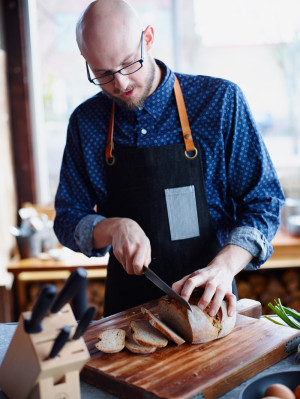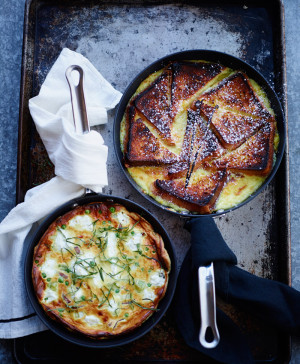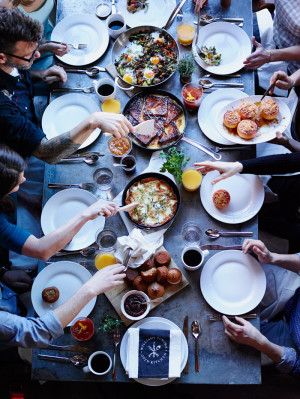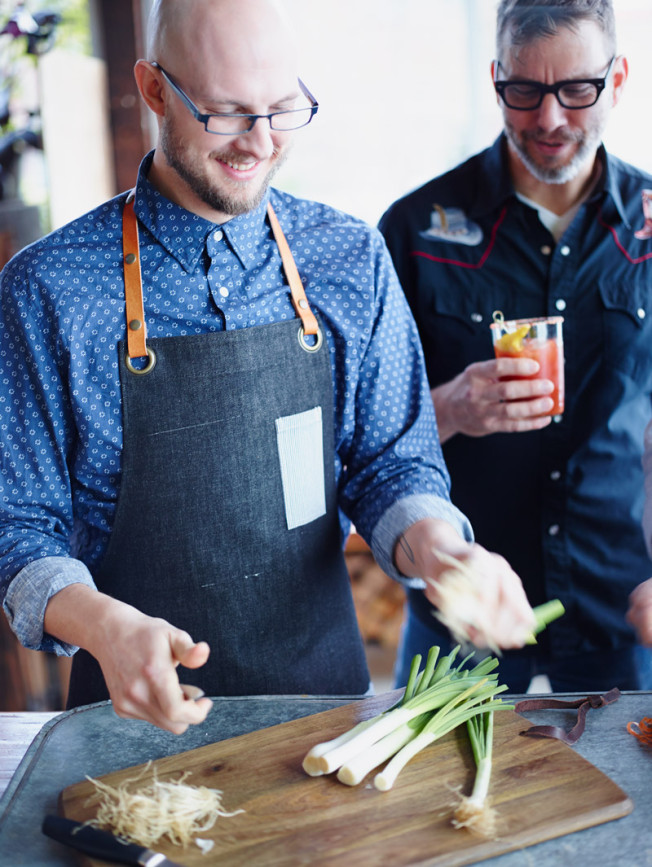We partnered with with the team at Ned Ludd, a Portland restaurant that feels like home, to bring our Open Kitchen collection to life this season. Its cozy, casual vibe pairs perfectly with its rustic menu, which highlights peak-season produce and handcrafted, locally sourced ingredients. Read our interviews with the owners, chefs and partners behind Ned Ludd and try their original recipes here.
Lucian Prellwitz joined Ned Ludd about a year and a half ago, drawn to the restaurant by its signature wood-fired oven and handcrafted approach to cooking. Now, he and his team execute Chef/Owner Jason French’s larger vision for the restaurant: an American craft kitchen devoted to local ingredients and purveyors and artisanal techniques. Here, we ask Lucian all about the food he serves, his relationships with producers, and his top Portland picks.
What’s your background? How did you become a chef?
I’m originally from the midwest — Indiana. My dad’s side of the family is big, so I was introduced to food and its importance through large family gatherings. We had a habit of talking about the next meal while eating the current one. I worked in the front of house in restaurants throughout high school; I was always interested in food.
I went to college for music but got burnt out pretty quickly (I was a classical trumpet player). I decided to try cooking professionally to see if I liked it as much as I thought I would, and I did, in Bloomington, Indiana. I decided to go with that career path, so I was either going to New York or San Francisco. I went to SF — I went with product over anything else.
I worked at Firefly for four years, the last 2 as Chef de Cuisine. Then I took a job at the French Laundry for a few months, and then I was Sous Chef at Ubuntu in Napa. I was there for a year before I got a panicked phone call from Brad at Firefly, and I ended up going back for 16 months before heading up to Portland. I had taken a trip up there a couple of summers before, and I’d read about Jason and Ned Ludd. I was curious about cooking with wood and the old-world techniques and approach to food. He was this crazy guy in Portland running a restaurant with just a wood oven! I got in touch and spent a couple of days at the restaurant, and we stayed in touch. When I drifted up that way from San Francisco, the timing was just right.

Tell us about the menu at Ned Ludd. How would you describe the food?
We go with: it’s clean and dirty, rustic yet elegant. My personal approach is to under-sell it and over-deliver. Things like braised celery — how delicious can it be? But when you put thought and care into the technique, it’s really good. We use simple vegetables. A lot of chefs are searching for the next trend, unknown ingredients, but there’s got to be someone around trying to keep the traditional approach alive. It’s super appealing to me – it is, by design, a restaurant in reverse. We do classic stuff, but what makes it so great are the technique and thoughtfulness and mindfulness that go into it. From my perspective, it’s attention and intention working together in producing the final product.
How has it been working with the wood oven? Has it changed the way you cook?
I have to be a much more thoughtful cook and chef in the planning and execution of things. It presents a challenge, but I’ve always enjoyed working with tight parameters; being able to focus like that has helped me. At Firefly I would constrict myself, saying, this week the menu is more French, next week it’s more Japanese, etc. I’d put influences and constraints on the menu. Hence the move to Ubuntu: it was all vegetables. Being at Ned Ludd for 16 months, just having that oven, I feel focused. I think there’s a certain life itself to the oven, to the fire. You have to pay attention to it as well and figure out different ways to make things work.
What is your goal with the food you serve at the restaurant?
One important thing is maintaining tradition. Beyond that, cooking is a craft, and it can get blurred at some point into the lines of art. Theres a place for all of that, but you have to remember that it’s a craft and that you’re feeding people. Feeding them and nurturing them. If there’s something we can make, we’ll make it ourselves. Putting that intention shows care and a desire to take care of and welcome people into your home.
How do you work with local producers?
We get email lists and phone calls from the people we work with, and we talk to them directly. I actually see most of them every week. They are always curious — what would you think if we grew it to this size, or did this or that? What are you interested in? There’s a real banter and openness back and forth with the folks we work with. It’s important to surround ourselves with like-minded people in the food realm.
What about atmosphere in the restaurant? What have you done to make it fun, casual and creative?
From our end, the kitchen is completely exposed to the dining room; there’s a large wooden counter that separates the two. When you walk in, the first thing you see is the fire in the oven. It doesn’t matter how many times I’ve done it, walking in there, it’s always warm and welcoming. We’re feet away from a couple of the tables, so there’s plenty of time for the cooks and myself and Jason to talk to people. We try to make the effort; people are always curious about the oven and what it is we do. Whenever possible, we’ll welcome people back to get a closer look.
 What was the inspiration behind the menu you created for our Open Kitchen meal?
What was the inspiration behind the menu you created for our Open Kitchen meal?
The menu was leaning towards spring, which is nice. It was full of things that are staples, in some form or another, on our weekly brunch menus — that was the starting point. We’re not going to do something we don’t usually do; it should be representative of the restaurant. Also, we wanted to do items that would translate well for a group of 8 or so.
Any tips for recreating it at home?
Jason and I joke that with a lot of the stuff we do, the menu writes itself. I’ll sit down Sunday night with sheets from our farms and order stuff with no real purpose as to where it’s going to go, and when we see it we decide how to cook it. It’s a lot of plug and play. The recipes we provided are a good starting point– the main concept is fairly solid — but the ingredients can be swapped out for something that looks better at the market. It’s about following those instincts and being OK with adapting.
What about serving ideas?
With this menu, feel it out for yourself, but some foods are delicious at room temperature. Things don’t always have to be ripping hot from an oven. Especially as we get toward the warmer months, we open the patio and get into the idea of things that are warm but not hot. When you’re serving a large group, be mindful of not putting too much work on yourself so that you can enjoy it. I like a mix of room temperature and warm things.
What’s your relationship with the other people at the meal? How do you all work together?
Jason and Michelle and I work together, and his two daughters were there. Our friend Alan is around the restaurant a lot — he’s a great guy. Willie and Rebekah own Heart Coffee, which we use at the restaurant, and Willie and Jason and I play golf together, which is hilarious. We’re using his products and hanging out, just as like-minded folks. Dave and Lori have Creative Growers, a farm I really enjoy. I enjoy working with him and talking to him. I order things that aren’t on his list and he’ll send them to me anyway. We have a fun relationship in that regard.
What’s your definition of a successful dinner party?
Good music. Lots of laughter. From there, the rest can kind of float around.
Do you cook and entertain at home? What does that look like?
I do cook at home; I made breakfast this morning. Simple things, things I want to eat, things on toast. If I’m lucky to have two days off, I try to cook one of those days. I know my girlfriend would love for me to cook for her as well!

What do you love about Portland?
I visited a couple of times before I decided to move here. I was done with San Francisco in terms of expense; it was no longer worth it. I was looking for a cheaper place but with a similar mindset. They are two like-minded cities, but here there’s more space and a lower cost of living. Also, the food scene is developed enough to feel satisfying but young enough to have an edge of potential — you can do whatever you want here and people are into supporting it, at least for a while.
What inspires you about living here?
I really enjoy the space. It’s super easy to get around. I was with my roommate, who also cooks at Ned Ludd, and we pulled up to Lardo Sandwich Shop and parked right in front. I’ve been here since last December, and every time I go somewhere, there’s parking right in front. San Francisco was more of an ordeal, but here I feel more relaxed. Days in the restaurant can be filled with intensity and stress, but the city doesn’t feel stressful. That’s what’s keeping me around.
What about the food?
I’m really stoked on all the producers around. We have people making coffee and cheese, growing vegetables, and raising meat and fish all within 20 miles of the city. That’s the most exciting thing for me.
Describe your perfect food day in Portland. Where would you go?
First, honey pie and coffee at Sweedeedee — that’s a great way to start. Then a late lunch at Little Bird, with oysters, a little charcuterie, and a little gnocchi. I just had one with salt cod.
I drink expensive whiskey and cheap beer. I’d go to this whiskey bar on my bike ride home called Branch Whiskey Bar — it’s simple inside but probably has 40 to 50 bottles.
Read more about our brunch with Ned Ludd here.

